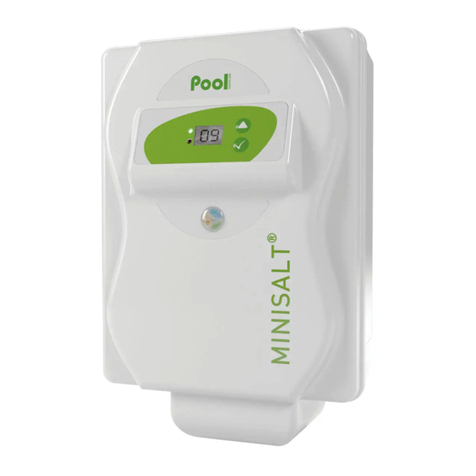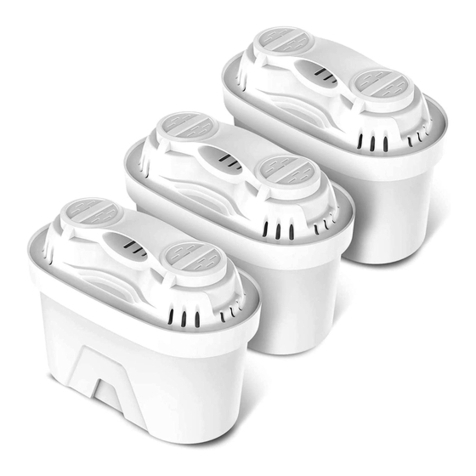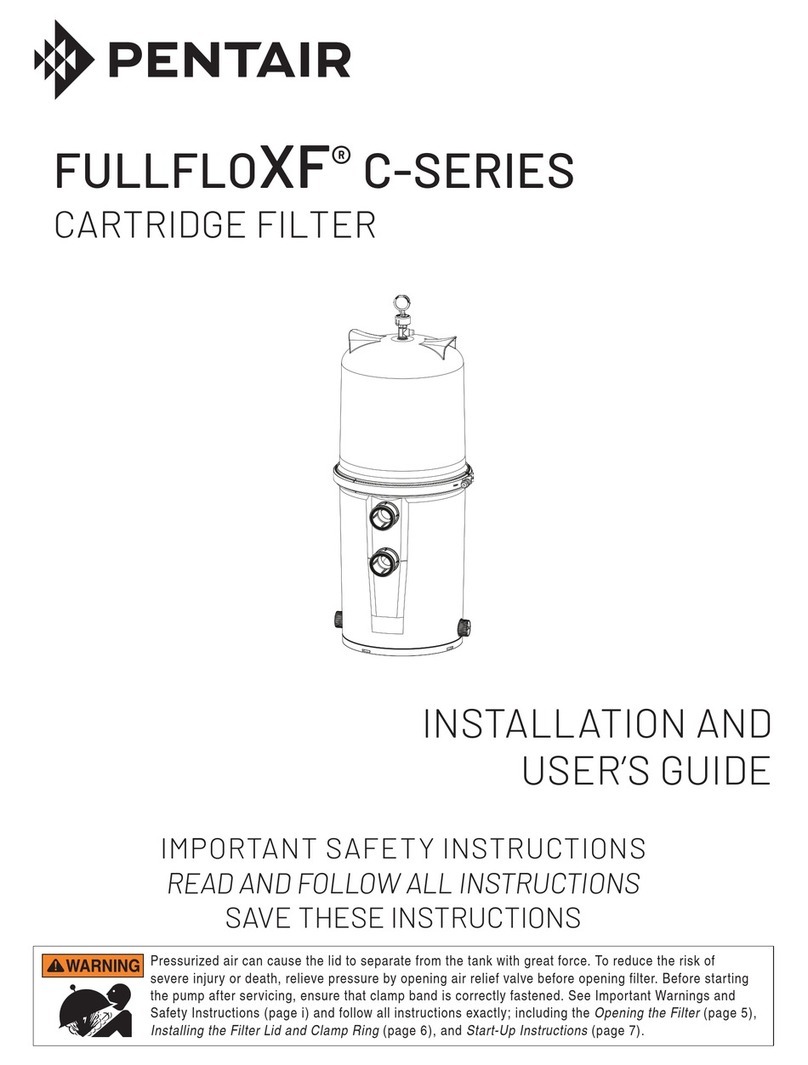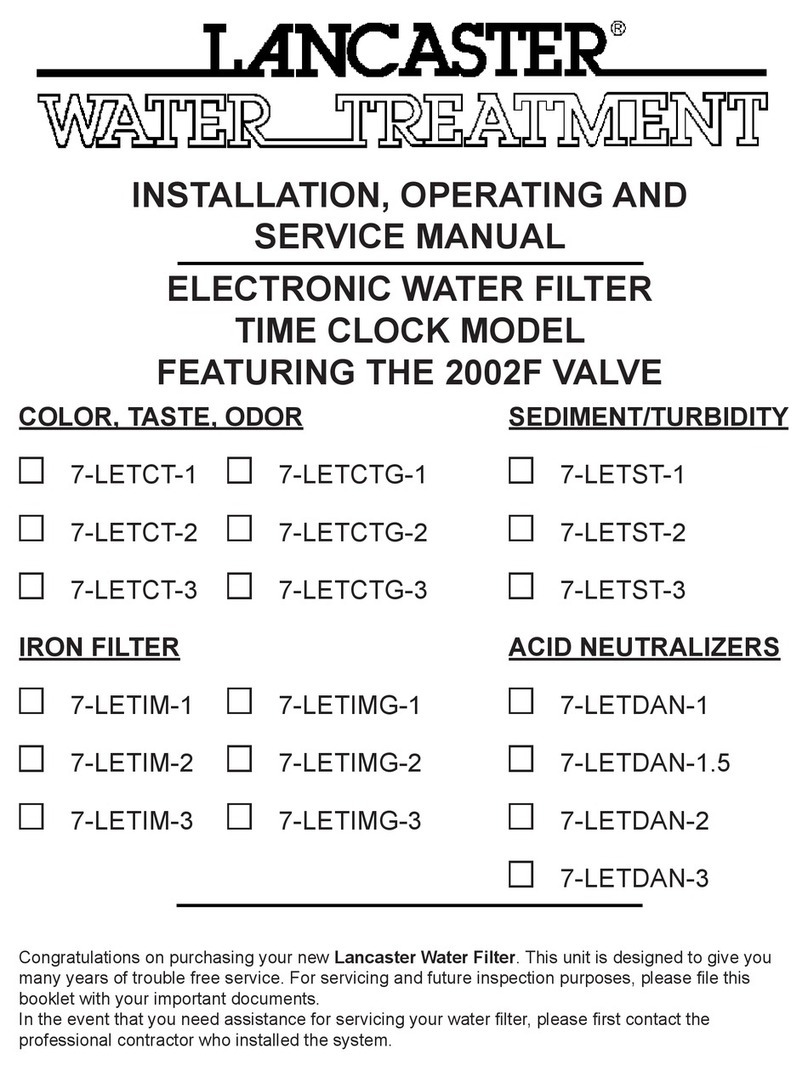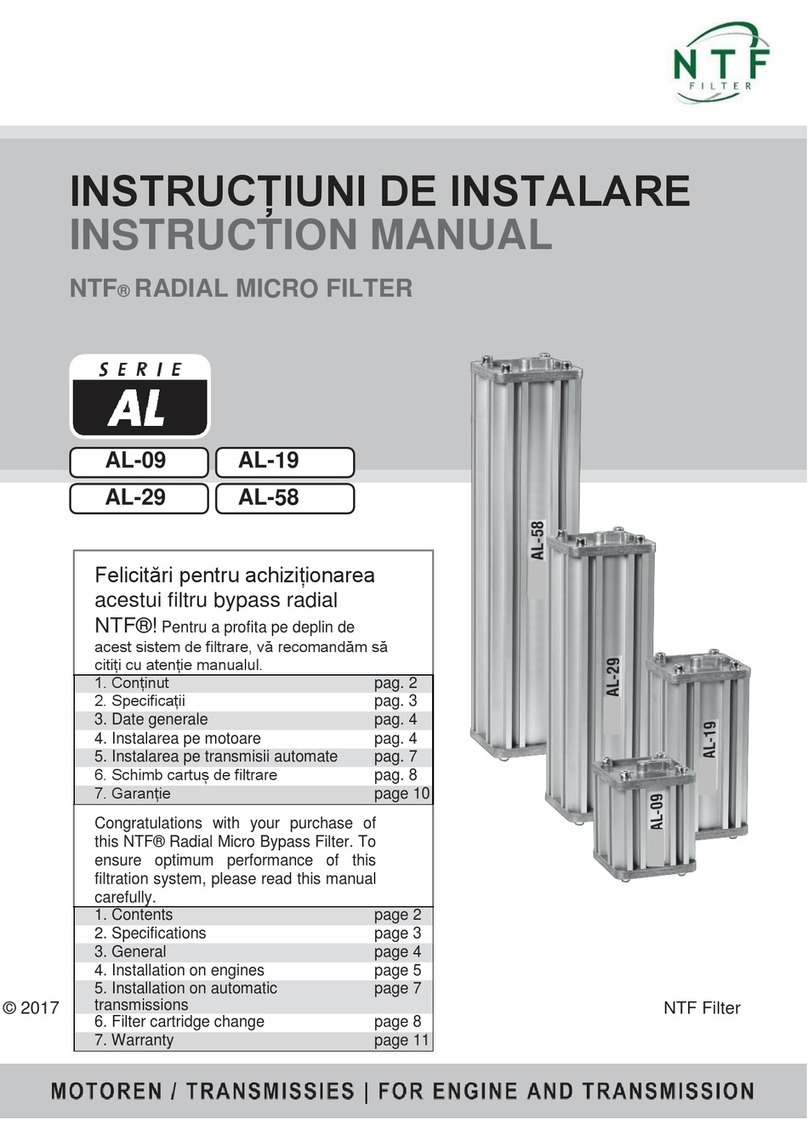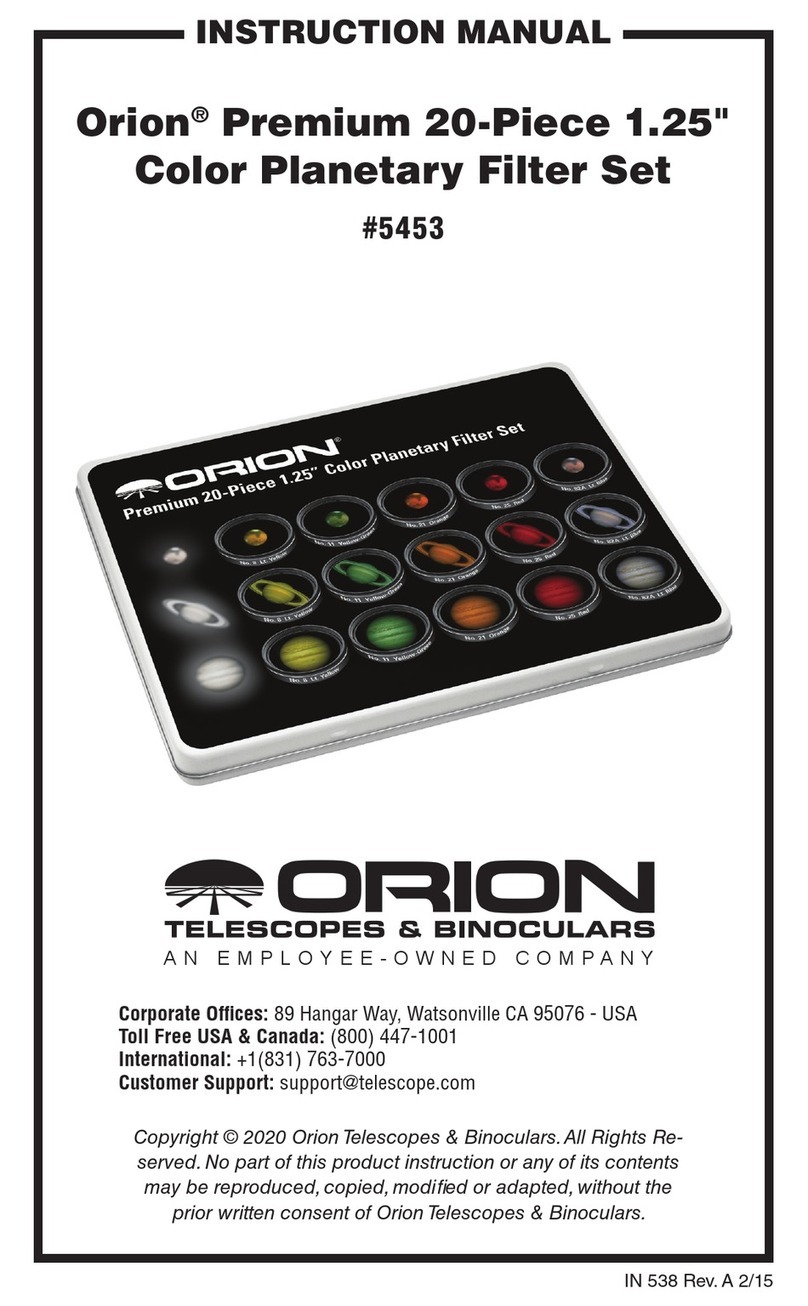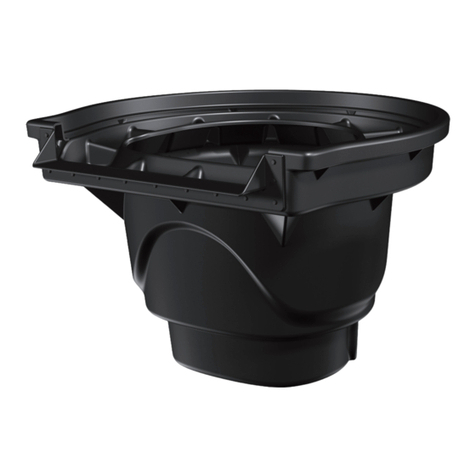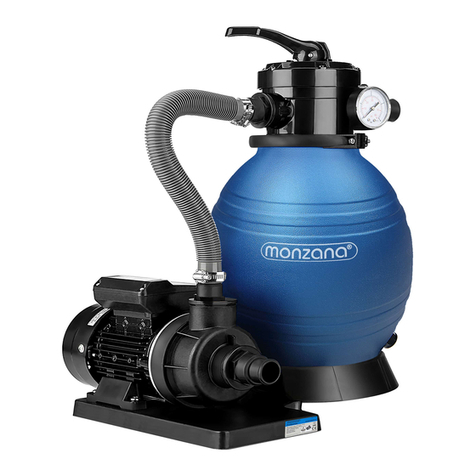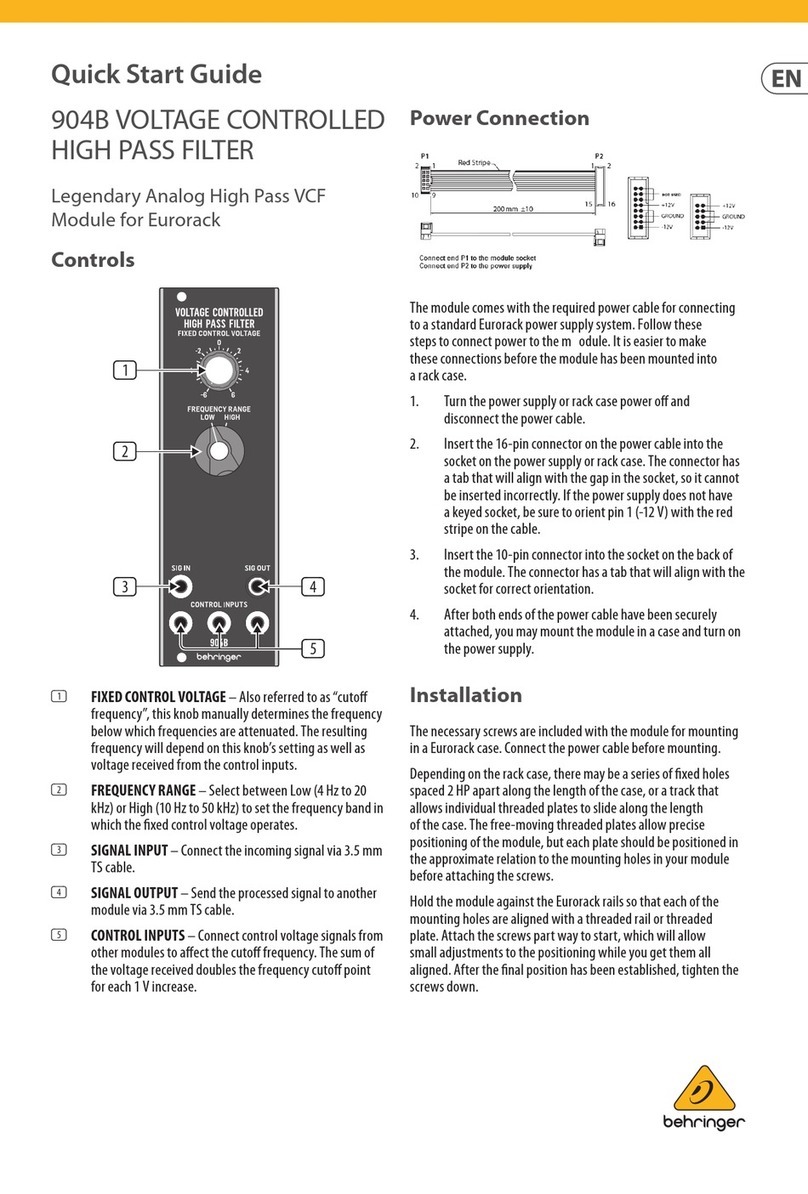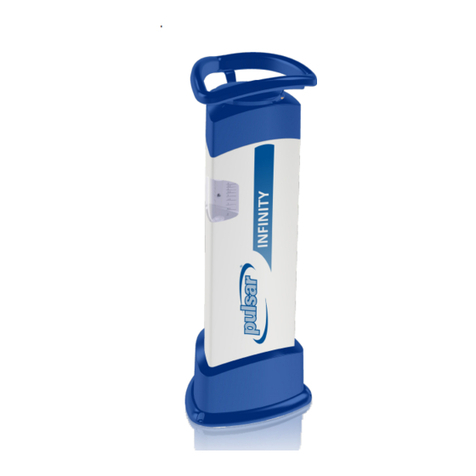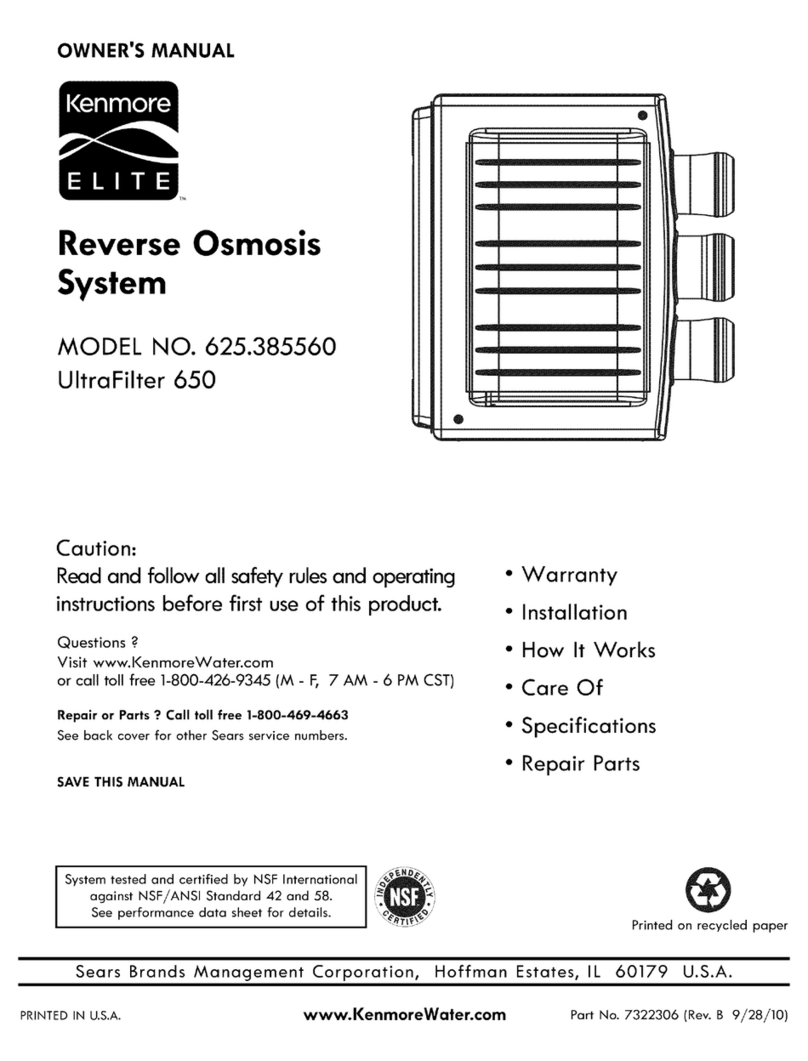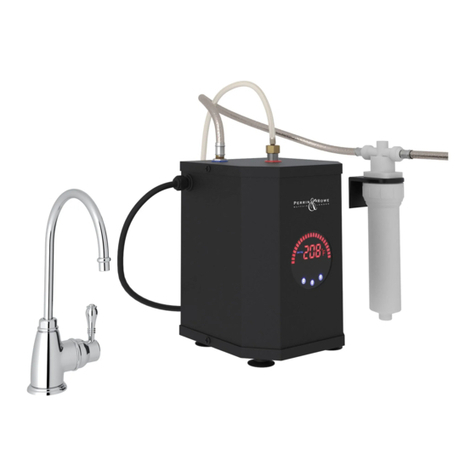Nelsen Corporation Aqua Classic Manual

Reverse Osmosis
Drinking Water Systems
Installation, Operation & Service Manual
Including Systems with
optional ECF Module


SECTION I. Introduction
Congratulations, you have just purchased one of the
finest Reverse Osmosis Drinking Water Appliances
available. The Aqua Classic and the Aqua Elite Reverse
Osmosis Systems have a combined engineering and
experience level of some 35 years behind them. They
were designed with a minimum of service and will
serve you for years to come.
Like any other fine product, this appliance requires
periodic maintenance in accordance with the schedule
outlined below.
Recommended Filter Change Schedule*
1) Pre-Filter, 10”, 5 Micron........................ 6 Months
2) Granulated Activated Carbon ................ 6 Months
Post-Filter
3) Reverse Osmosis Membrane ....... 24 - 36 Months
4) Pre-Carbon Filter For Chlorine ............... 6 Months
Removal (Aqua Classic II and
Aqua Elite II RO Systems Only)
5) Extended Contact Carbon...................... 6 Months
Adsorbtion Filter (ECF Module - Optional)
*Based on standard conditions.
Your new Reverse Osmosis (R.O.) Drinking Water sys-
tem uses a combination of filtration technologies to
reduce unwanted contaminants in a water supply. The
following steps combine to give you the best in clear
sparkling drinking water:
MECHANICAL FILTRATION - The sediment pre-filter
will remove the larger particles such as silt, rust and
scale. Its 5 micron (equal to 0.0002 inch) nominal rat-
ing helps to give maximum life to the R.O. Membrane
and carbon filter.
ACTIVATED CARBON PRE FILTER -
Found only on the Aqua Classic II and Aqua Elite II
(3-filter housing) RO Systems - The activated carbon
in this pre-filter will remove any chlorine that may be
present in the feed water. This pre-treatment is also
necessary for membrane protection.
REVERSE OSMOSIS MEMBRANE - The R.O. Mem-
brane is the heart of the filtration system. It is designed
to reduce the dissolved mineral content of the water.
Minerals picked up in the environment by the water
are measured as Total Dissolved Solids (T.D.S.). In
the Reverse Osmosis process, dissolved minerals are
separated from the incoming water (Feed Water) to
produce the product water (the Permeate). The excess
minerals are rinsed to drain (the Reject Water). The spi-
ral wound construction of the R.O. Membrane provides
maximum surface area for water production and is less
susceptible to fouling by particulate matter, turbidity
and colloidal materials.
TFC Membranes - Thin Film Composite (T.F.C.) Mem-
branes are specially constructed, fully aromatic poly-
amide film and are classified as a thin film composite.
These membranes are NOT chlorine resistant.
ACTIVATED CARBON POST FILTER - The Activated
Carbon Post Filter cartridge contains carbon particles
with a vast network of pores. The tremendous surface
area of these pores (typically 800-1200 square meters
per gram of carbon) gives the carbon very good ad-
sorptive sites for chlorine as well as other substances
that contribute to tastes and odors. The product water
from the membrane as well as the holding tank passes
through the Activated Carbon Post filter on the way to
the Dispensing Faucet. The Activated Carbon Post Filter
reduces tastes and odors that may pass through the
system. It adds a final “polish” to the water.
EXTENDED CONTACT CARBON ADSORPTION
FILTER (ECF Module - Optional) - This slow flow car-
bon filter is designed to reduce certain organic com-
pounds and chloramines.
AUTOMATIC SHUT-OFF VALVE - The A.S.O. Valve
senses when the product water tank is full and closes
the feed water supply to prevent excess reject water
from going to drain when the unit is not producing water.
System Recommended Operating Limits for Feed Water
Feed Water T.D.S.........................................................................................................2000 ppm max
Feed Water Temperature.............................................................................................40 - 110° F
Feed Water pH.................................................................................................................................................... 5 - 10
Feed Water Pressure......................................................................................................40 - 85 P.S.I.
Feed Water Hardness............................... Less Than 10 Grains Per Gallon
Feed Water Iron................................................................................................. Less than 0.1 ppm
Feed Water Manganese............................................................... Less than 0.05 ppm
Feed Water Hydrogen Sulfide.............................................................................................. NONE
Feed Water Supply................................................................................................................No Chlorine
Feed Water Bacteria........................................................................................ Must Be Potable
-1-

-2-
INLET (3/8" Orange)
DRAIN
(1/4" Red)
4" MIN. CARBON
Post Filter
Housing
SEDIMENT
Pre-Filter
Housing
DRAIN
(3/8" Black)
Dispensing Faucet with Air Gap
(for non-air gap installations
please see Figure 4, Page 14
Self Piercing
Saddle Valve
(cold water line only)
PRODUCT
(3/8" Blue)
DRAIN CLAMP
(locate above “P” trap)
Holding Tank
Shutoff Valve
(open position)
TANK (3/8" Yellow)
REVERSE OSMOSIS ASSEMBLY
(NOTE: Aqua Classic II and Aqua Elite II
R.O. Systems include a third filter housing;
the optional ECF Module would appear on
the top of the system. The installation
would be similar to that shown.)
Drinking Water
Holding Tank
SECTION II. Installation And Specifications
FIGURE 1 Installation Diagram
Nelsen
Corporation

-3-
SECTION III: Preparation
A. Major System Components
The following components comprise the R.O.
Drinking Water System (Refer to Fig. 1. page 2 for
general system layout.)
1) A R.O. assembly consisting of the black aluminum
bracket, filter housings, automatic shut-off and
membrane module
2) A Drinking Water Holding Tank
3) A Faucet Kit
4) A plastic tubing kit with self-piercing saddle valve
and drain clamp
5) Other items necessary for installation may include
wood screws or machine screws for mounting the
R.O. assembly, or concrete anchors for hanging
on basement wall, additional tubing or tube
connectors, plastic wire ties for organizing tubing
Optional Components
1) ECF Module - Extended Contact Carbon Adsorption
Filter located on the R.O. Assembly
2) A T.D.S. Monitor Kit (optional*) with feed water
and product water test cells
* The T.D.S. Monitor may be necessary to conform
to state or local codes, check with the local
plumbing authority.
B. Tools Recommended for Installation
The following tools will cover most of the installation
sites encountered:
1) 3/8" variable speed electric drill
2) Extension work light with outlet
3) Safety Glasses
4) 1-1/4" porcelain hole cutter kit
5) 1-1/4" Greenlee hole punch and 1/8" and 1/2"
metal drill bits for pilot hole
6) Center punch and hammer
7) 1-1/4" wood bit
8) Concrete drill bits
9) Assorted wood and metal drill bits including
7/32" metal drill bit
10) Phillips head and flat blade screwdrivers
11) 1/2", 9/16" and 5/8" open end wrench
12) 10" Crescent wrench with jaws taped to
hold faucet
13) Basin wrench or 10" pipe wrench
14) Teflon tape
15) Wide masking tape or duct tape
16) Plastic tubing cutter
17) Extra plastic tubing
18) Low range air pressure gauge
19) Bicycle hand air pump
20) Small bottle of liquid chlorine bleach
21) Graduated measuring cylinder
22) Assorted clean up materials
C. Determine System Location
The appliance can be located under a sink or in a
basement depending on space availability and the
customer’s preference. If a basement installation is
selected, additional tubing, hardware and fittings may
be needed and a hole will have to be made from inside
the cabinet, through the floor, to the basement. Never
install in an area of the home where temperature is
freezing as damage to the system will result.
The exact placement of the various components of the
appliance will vary from installation to installation. The
installer, in conjunction with the customer, must decide
on where to place the faucet, tank and purification
assembly by balancing the homeowner’s convenience
with ease of installation and servicing.
Considerations for an ice maker or other remote
hookup should be determined, including routing
and any additional tools, fittings, and tubing that
may be required.
1) Faucet - The faucet should be placed near the sink
where drinking water is normally obtained. Conve-
nience of use (filling of water pitchers and glasses),
and an open area beneath the faucet under the
sink for attaching product and drain tubing (air gap
faucets only) are considerations. A 2" diameter flat
surface is required above and below the mounting
site. The thickness of the mounting surface should
not exceed 1-1/4". Watch for strengthening
webbing on the underside of cast iron sinks.
2) Drinking Water Holding Tank - The holding tank
may be placed where it is convenient within
10 feet of the faucet, under the sink or in an
adjacent cabinet are best choices. If a longer run
of tubing is required, the tubing should be the 1/2"
diameter O.D. size to prevent a high pressure drop.

-4-
Remember, these tanks can weigh up to
30 pounds when full of water, a firm, level area
is required.
3) R.O Assembly - The R.O. Assembly may be
mounted on either the right or left side of the
under-sink area or a cabinet. Mounting in the
basement is also an option, one possible location
is near the laundry/utility sink where cold potable
water and drain access is handy. The mounting
location should allow adequate clearance and
accessibility for cartridge changes.
4) Feed Water Connection - The self-piercing
feed water shut off valve should be located as
close to the R.O. assembly as possible. USE A
POTABLE COLD WATER SUPPLY ONLY. Softened
water is preferred as it will extend the life of the
R.O. Membrane.
5) Drain Connection - The drain saddle assembly is
designed to fit around a standard 1-1/2" OD drain
pipe. The drain saddle should always be installed
above (before) the trap and on the vertical
or horizontal tailpiece. Never install the drain
saddle close to the outlet of a garbage disposal
or plugging of the RO drain line may occur. If
discharging into an utility sink or standpipe, an air
gap of greater than 1" above the flood rim must be
provided. Do NOT connect the system drain line to
the dishwasher drain or near the garbage disposal.
Back pressure from these units may cause the air
gap to overflow.
D. Prepare the Area for Installation
If a basement installation is called for, determine
where components will be located and how they will
be mounted. Special mounting brackets and hardware
may be necessary to secure the system to a wall or
ceiling joists.
Inspect cold water supply line and drain to determine
if any special fittings, in addition to what is included in
the kit, are required.
E. Prepare the Appliance for Installation
Open shipping carton and remove components. Check
that all installation parts are present which includes the
purification assembly, storage tank, faucet, installation
hardware and tubing.
Check that the air supply in the empty tank is
approximately 7 psi. Adjust if necessary.
To assure you the highest level of purity, the 5 Micron
Sediment Cartridge, GAC Cartridge and Reverse
Osmosis Membrane have been included separately in
special packaging.
The proper method of installation is outlined below.
Installation of the 5 micron Sediment Prefilter
Cartridge
Completely unscrew and remove the “PREFILTER”
housing from the appliance. Remove the protective film
from the white Sediment Cartridge. Carefully center
the cartridge in the housing before reassembling. As
you reassemble the housing to the appliance make
sure the cartridge is centered on both the filter housing
head and the housing itself. Once tight, the “PREFIL-
TER” label on the filter housing should be centered on
the “FEED WATER” label and elbow on the front of the
appliance.
Installation of the GAC Postfilter Cartridge
The GAC “POSTFILTER” Cartridge is installed in the
same manner as outlined above for the “PREFILTER”.
Installation of the Reverse Osmosis (RO) Membrane
The RO Membrane has also been shipped to you
separately. Remove the tubing from the endcap of the
membrane housing, and unscrewed the end cap, insert
the membrane as illustrated below. The O-rings on
the product water tube of the membrane MUST FULLY
SEAT in the membrane housing for proper operation.
Also make sure that the Brine Seal on the membrane
seals with no gaps or wrinkles inside the membrane
housing. Once the membrane is installed, replace the
end cap and re-connect the tubing.
To insure that all the special preservative is flushed
from the system before use, DO NOT use the first two
tankfuls of water produced by the system.
Nelsen
Corporation
MEMBRANE HOUSING
INSERT BRINE SEAL
MEMBRANE

-5-
SECTION IV: Installation Steps
All plumbing should be done in accordance with state
and local plumbing codes.
NOTE: Some codes may require installation by
a licensed plumber; check with the local
plumbing authority prior to installation.
In restricted under-sink areas, it may be easier to
install the faucet first. Allow adequate tubing lengths
for any final component position.
A. Install The Faucet
NOTE: For Faucet Assembly Diagram,
please see Figure 2, below.
Under counter installations generally require that the
faucet is installed with the built in air gap connected.
In basement installations, the built in air gap does not
have to be used only if one is provided elsewhere in
the drain line.
A non air gap faucet, which requires a smaller 9/16"
mounting hole, is available from the factory to make
basement installations easier.
If the sink already has a hole provided that can accom-
modate the RO faucet, then no drilling is required and
you can proceed to the section on mounting the faucet.
NOTE: Sprayers can be disconnected to provide
a suitable hole for the RO faucet. A pipe
cap or plug will be required to seal the
sprayer connection.
1. Make The Faucet Mounting Hole
IMPORTANT:
It is mandatory that safety glasses
be worn during sink hole drilling
operations to prevent eye injury.
Before starting the hole making operation, always
check below the sink so that nothing interferes with
mounting the faucet such as reinforcing ribs, support
brackets or cabinet construction.
Stainless Steel Sink, Air Gap or Non Air Gap Faucet:
Recommended tools:
•Centerpunch
•Variablespeeddrillandhighspeeddrillbits.
•Greenleechassispunch7/8"holesize(alternate
9/16" size may be used for non air gap faucet)
•Protectivegloves
Procedure:
a) Center punch a small indent at the desired
faucet location.
Nelsen
Corporation
NON-AIR GAP FAUCETAIR GAP FAUCET
1/4" Standard
Red Tubing
Air Gap Hole
Black 3/8"
Reject
Tubing to
Drain
Blue 3/8" Product
Water Tubing
Chrome Base Plate
Rubber Washer
Plastic Bottom Washer
Flat Washer
Star Washer
Hex Nut
3/8" Faucet Adaptor
Blue 3/8" Product
Water Tubing
Threaded Nipple
CL
Chrome Base Plate
Rubber Washer
Slotted Washer
Spacer
Flat Washer
Threaded Nipple
Hex Nut
3/8" Faucet Adapter
Blue 3/8" Product
Water Tubing
FIGURE 2 Faucet Installation Diagram

b) Slowly drill the required pilot hole for the
chassis punch.
c) Set up the chassis punch per instructions and
tighten nut to cut the desired hole size.
d) Clean up sharp edges with a file if necessary.
Porcelain/Enamel/Ceramic on Sheet Metal or Cast Iron
Base; Faucet with or without Air Gap Module:
Recommended tools:
•Variablespeeddrill
•Reltonporcelaincuttertoolset7/8"size
(alternate 9/16" size may be used for air gap or non
air gap faucet)
•Plumber’sputty
It is important to understand what is involved in this
procedure. First, the glassy layer of porcelain must be
penetrated through to the base metal. Second, a center
disc of porcelain must be removed while protecting the
surrounding porcelain against chipping or fracturing.
Third, the base metal must be drilled through to com-
plete the hole.
Procedure:
a) Mark the center for the 7/8" hole
b) Form a shallow putty dam around hole area
and fill with enough water to lubricate carbide drill
bit.
c) Carefully drill pilot hole through porcelain/enamel
and base metal using carbide type pilot drill.
IMPORTANT:
Always operate drill with light
pressure at slow speed (300-400 rpm)
d) Insert pilot tip of spring-loaded porcelain cutter
into pilot hole.
e) Drill porcelain/enamel using spring-loaded por-
celain cutter, making certain a complete ring has
been cut through the porcelain/enamel to the
metal base.
f) Change to the metal cutter. With slow speed and
light pressure, cut away the inner porcelain/enam-
el disc down to base metal. Make certain that the
cutter does not touch outer rim of the cut porce-
lain/enamel. Continue with this bit to cut through
metal until sink has been completely penetrated.
IMPORTANT:
When using a porcelain cutter it is
critical to take precautions that it
is always in a sharpened condition.
Dull cutters are known to chip sinks.
2. Mount The Faucet:
NOTE: For Basement Installation Without Air
Gap Module See Figure 6, Page 16.
Under Counter Installation with Air Gap Faucet:
a) Familiarize yourself with all components shown
in the air gap faucet diagram.
b) Disassemble hardware from the threaded nipple,
except for chrome base plate and rubber washer.
NOTE: Rubber washer may be replaced with bead
of plumber’s putty for neater appearance.
c) Connect length of standard red 1/4" tubing to
smaller barb on air gap faucet. Push on firmly until
it seats.
d) Connect length of black 3/8" tubing to larger barb
on air gap faucet. Push on firmly until it seats.
e) Feed the air gap tubing and threaded nipple
through sink/counter mounting hole and orient
the faucet as discussed with the customer.
f) From below sink/counter assemble the white
spacer (open end up, open side toward air gap),
flat washer and hex nut on threaded nipple and
tighten by hand.
g) Back off on hex nut just enough to slide slotted
washer between white spacer and underside of
sink/counter (with open side of slotted washer
closest to air gap tubes)
h) After rechecking faucet orientation, tighten hex
nut (9/16" wrench or deep socket) until faucet
feels secure.
i) From above the sink make any minor orientation
corrections by turning the faucet with a padded
adjustable wrench.
Note: Flats on chrome faucet may be used for
tightening with an adjustable wrench. Use
care not to mar chrome finish.
-6-
Nelsen
Corporation

-7-
B. Install the Feed Water Valve and Tubing
The saddle tapping valve supplied is designed for use
with 3/8" to 1/2" OD soft copper supply tubing (plain or
chrome) and rigid metal pipe (see below). Do not use
with flexible ribbed supply tubing which has too thin a
wall thickness and requires special hardware. If neces-
sary, refer to the diagrams on page 19 for the correct
use of the “John Guest” fittings.
Soft Copper Tubing Installations:
1) Turn off cold water valve under the sink, or main
valve for the house.
2) Before installing saddle tapping valve, make
sure piercing lance does not protrude beyond
rubber gasket.
3 Assemble saddle tapping valve on copper tubing.
See Figure 3.
4) To pierce soft copper tube, turn handle
clockwise until it is firmly seated. The valve is
closed in this position.
5) Turn on main supply valve to pressurize cold water
line. Check for leaks. With a wrench snug nut/seal
around valve stem.
NOTE: For basement installations the existing
orange feed water tubing may have to be
longer to reach feed valve.
6) Connect one end of the orange tubing to the feed
water valve using brass compression nut, insert
and plastic sleeve.
Rigid Metal Pipe Installations:
1) Turn off cold water supply valve and drain the line
to prevent spillage.
2) Drill 3/16" hole at the desired location. To prevent
shock hazard, use a battery operated drill.
3) Before installing saddle tapping valve, make
sure piercing lance does not protrude beyond
rubber gasket.
4) Assemble saddle tapping valve on copper tubing.
See Figure 3.
5) Turn saddle valve handle clockwise to close valve.
With a wrench tighten nut/seal around valve stem.
6) When you wish to open valve and supply
cold water to the unit, turn valve handle
counterclockwise.
7) Connect one end of the orange tubing to the feed
water valve using brass compression nut, insert,
and plastic sleeve.
NOTE: For basement installations the existing
orange feed water tubing may have to be
longer to reach feed valve.
C. Prefill and Sanitize the Storage Tank
Prefilling the tank is always recommended so there
is pressure to check for leaks and several gallons of
water to flush carbon post filter. Tanks are furnished
with a special disinfectant and only require filling with
water for 15 minutes to be completely sanitized. An
instruction tag will accompany the tank. It is important
to use a sanitizer when prefilling tank so the solution
can sanitize the tubing, fittings, and faucet at the time
of installation and startup.
1) Insert free end of orange feed water tubing into the
“John Guest” fitting on the storage tank.
2) Open feed water valve and tank valve and allow
tank to fill (about 3 minutes).
Tightening
Screw
Reversible
Backplate
Valve Handle
Tubing to
RO Inlet
“John Guest”
Fitting
FIGURE 3 Feed Valve Installation
Nelsen
Corporation

-8-
3) Turn off feed water valve and tank valve and set
tank aside (15 minutes min).
D. Install the Drain Connection
NOTE: For Basement Installation See Figure 6,
Page 16.
Under counter Installations:
IMPORTANT: Before starting this procedure,
inspect the condition of the drain
piping, especially in older homes
where the traps and tailpieces can
be deceptively thin and frail. If in
poor condition, the condition
should be remedied.
The drain saddle assembly is designed to fit around a
standard 1-1/2" OD drain pipe.
The drain saddle should always be installed above
(before) the trap and on the vertical or horizontal
tailpiece. Never install the drain saddle close to the
outlet of a garbage disposal or plugging of the RO drain
line may occur. See Figure 4.
1) Position threaded half of drain saddle at selected
location and mark the spot through the opening.
See diagram.
2) Drill a 1/4" hole at the marked spot through one
side of drain tailpiece.
3) Position both halves of drain saddle on drain pipe
so threaded opening lines up with the hole in
drain pipe.
4) Use bolts and nuts to clamp drain saddle onto
drain pipe. Do not over tighten and make sure
there is equal space between saddle halves on
each side. See diagram.
5) Wrap teflon tape on thread of “John Guest” fitting
and tighten into drain saddle.
E. Make Initial Tubing Connections
NOTE: For Basement Installation See Figure 6,
Page 16.
Under counter Installation:
1) It is advantageous to make some of the tubing
connections at this time, since the under-sink
work area is not so cramped and access to the
components is easier. If necessary, refer to the
enclosed diagram on use of the “John Guest”
plastic fittings.
2) The orange 3/8" tubing should already have been
connected to the feed water valve with a 3/8"
brass compression nut, insert and plastic sleeve.
3) Tighten 3/8" plastic “John Guest” fitting onto
threaded faucet nipple. No Teflon tape is required
to make an effective seal. It may be necessary to
hold faucet from turning while tightening fitting.
4) Route black 3/8" tubing from faucet air gap to
drain saddle so that it slopes continuously down-
ward without loops or low spots. Cut to proper
length and connect to “John Guest” drain fitting.
F. Install the Purification Assembly &
Storage Assembly
NOTE: For Basement Installation See Figure 6,
Page 16.
Under counter Installation:
The purification assembly is usually mounted to the
right or left sink cabinet sidewall, taking into consider-
ation the space available and the tank location. Gener-
ally, the tank is placed in the rear of the cabinet while
Drain Pipe
Drain Clamp
Front Plate
“John Guest”
Locking Clip
1/4" Screw 1/4" Nut
“John Guest”
Fitting
1/4" Drilled Hole
FIGURE 4 Feed Valve Installation
Nelsen
Corporation

-9-
the purification assembly is positioned toward the front
for cartridge accessibility.
To mount the purification assembly elevate at least
2" off the cabinet floor and, while keeping level, mark
the location of the mounting holes on cabinet sidewall.
Make small pilot holes with an awl or drill and screw in
the two mounting screws, leaving just enough protrud-
ing to allow bracket mounting slots to slide over them.
NOTE: If the cabinet sidewalls are not of solid
construction, the purification assembly can
be set on the cabinet floor and held against
the sidewall with the mounting screws.
The tank may be oriented either vertically or
horizontally. It is generally placed to the rear of the
cabinet but can be set in the front center (between the
sink basins) for ease of access if space permits.
G. Make Final Tubing Connections
NOTE: For Basement Installation See Figure 6,
Page 16.
With all of the components in place, the final tubing
connections can be made. When routing tubing
between components, several guidelines should
be observed.
• Tubingrunsshouldgenerallyfollowthecontour
of the cabinets rather than interfere with the
cabinet storage area.
• Striveforneatnessandanorderlytubing“ow”
using fasteners (e.g. insulated staples) to secure
the tubing. Cut tubing to the desired length.
• Arrangethetubingsotherearenosharpbends
and leave some “play” in the tubing for ease
of servicing.
• Trytokeepthetubingfromthepuricationassem
bly to the tank and faucet as short as practical
for good flow. If necessary, refer to the enclosed
diagram on use of the “John Guest” plastic fittings.
Undersink Installation
1) Connect orange 3/8" tubing from feed water valve
to the “Feed” connection on purification assembly.
2) Connect yellow 3/8" tubing from purification as-
sembly to tank.
3) Remove “RED” plug from drain elbow, insert end
of red 1/4" tubing leading from faucet into drain
elbow. See figure 1, page 2.
4) Connect blue 3/8" tubing from purification assem-
bly to “John Guest” fitting on faucet.
H. Install Ice Maker Hookup (optional)
The RO drinking water appliance can be connected to
any standard refrigerator ice maker or ice maker/water
dispenser. It should never be connected to a commer-
cial type bar ice maker.
Hooking up an ice maker involves connecting a tee
with shut off valve into the blue 3/8" faucet tubing and
routing tubing over to the refrigerator. Hooking up to
existing copper tubing is generally not recommended
unless it is less than six months old. If copper tubing
must be used, then installation of a small in-line carbon
filter at the refrigerator connections is recommended.
Before turning off the existing tap water supply to a
refrigerator ice maker, always shut off the ice maker
first (usually by lifting the lever arm above the bin to
the uppermost position). The ice maker should only be
turned on again after the RO system has been drained
several times and the tank has a full supply of water.
NOTE: Before any service is performed on the RO
system, always turn off ice maker valve
and the ice maker unit. Only turn on when
system is operating and tank is full.
I. Start Up The System
1) Double check that all connections are secure.
2) Turn on feed water valve and check for leaks. If
any leaks are noted, turn off valve and correct
before proceeding.
NOTE: If a leak occurs at a “John Guest” fitting
refer to Page 19 for correct usage.
3) Turn on storage tank valve and open faucet until a
steady stream of water flows. Close faucet, wait
at least 5 minutes and carefully check for leaks.
Correct as necessary.

-10-
NOTE: When the system is first turned on, water
may intermittently “spurt” from the air
gap opening at side of air gap faucet. This
is perfectly normal, and is caused by air
trapped in the system. This will usually
disappear within a short time.
J. Flush System of Preservative &
Check Operation.
1) Lift faucet handle and allow tank to drain com-
pletely of sanitizing solution. Do Not Use This
Water. When tank is empty, the faucet will steadi-
ly drip. This is the rate water is processed by the
RO system.
2) With faucet handle in “up” position, measure the
rate of the steady drip from spout. Use a grad-
uated cylinder (in milliliters) and watch with a
second hand to calculate approximate production
in gallons per day (milliliters per minute X 0.38 =
gpd). Proceed to check reject flow rate by discon-
necting tubing at drain connection and measure as
per above. The ratio should be a minimum of 2.5
(reject) to 1 (product).
3) Close faucet and re-inspect system for leaks.
Instruct customer (or use special faucet tag
supplied) to wait at least 4 hours and drain tank
again. The water should be discarded as it may
contain some preservative/disinfectant solution.
4) System should be ready to use as soon as the tank
refills. If any objectionable taste is noticed after
second tank draining, wait and drain tank the fol-
lowing day. Only at this time should an ice maker
be turned on if one is connected to the system.
NOTE: If optional percent rejection is used and
indicates service is required, several
tankfulls of water may have to be used
to completely flush excess TDS from the
new Carbon Post Filter before the green
light will show.
K. Clean Up & Paperwork
1) Clean up the work thoroughly.
2)
Affix any special decals or stickers. Be sure to
record the house pressure and TDS for service files.
3) Familiarize family members with the general oper-
ation of their new RO drinking water appliance. In
particular, note the following on standard faucet:
•Thefaucethandlepositions,downfor
momentary flow, and up for continuous flow.
Also note the moveable spout.
•Thelocationofthefeedvalveandtankshutoff
valve as well as the procedure for turning them
off.
•Reviewthemanyusesofthewater(cooking,
soups, juices, ice cubes, baby formula, pets,
plants, etc.)
•Reviewtherecommendedmaintenancesched
ule as determined by local water conditions.
Section V: Appendix for
Basement Installations
The following variations are generally required for
basement installations:
A. Installing The Drain Connection
For basement installations, the drain saddle is generally
not used. Instead, the RO reject line is routed so that
it drains into a laundry sink, floor drain, or standpipe
through an approved air gap. See Figure 6 on Page 15.
B. Mounting The Faucet
Air Gap Faucet
Follow the installation instructions given earlier in this
manual. Do not hook up any air gap tubing to the fau-
cet since an alternate air gap will be used elsewhere in
the drain line.
Non Air Gap Faucet
1) Familiarize yourself with all components shown in
the diagram of the non-air gap faucet.
2) Assemble only the chrome base plate and rubber
sealing washer onto the threaded nipple. (Plumb-
er’s putty may be used in place of sealing washer
for neater appearance)
3) Feed threaded nipple through sink/counter mount-
ing hole (9/16" hole is adequate).

-11-
4) From below the sink/counter assemble plastic
bottom washer, flat washer, star washer, and hex
nut onto the threaded nipple. Hand tighten hex nut
until faucet feels snug.
5) After rechecking faucet orientation, tighten hex nut
(9/16" wrench or deep socket) until faucet feels
secure.
C. Making Initial Tubing Connections
1) A proper length of orange 3/8" feed water tubing
should already have been connected to feed water
valve with a brass compression nut, insert and
plastic sleeve.
2) Tighten 3/8" “John Guest” fitting onto the threaded
nipple. It may be necessary to hold faucet from
turning while tightening fitting.
3) Connect proper length of blue 3/8" tubing to faucet
fitting (See “John Guest” fitting instructions).
Route tubing through the floor to the vicinity of the
purification assembly location.
4) Route standard red 1/4" tubing from an appropriate
drain connection (e.g. laundry sink, floor drain,
stand pipe) to intended location of purification
assembly. An air gap must be installed between
outlet and drain connection.
D. Installing the Purification Assembly
& Storage Tank
The purification assembly is generally mounted to the
basement wall (using wall anchors) or to wood ceiling
supports. To mount the purification assembly, keep
bracket level and mark the location of the mounting
holes. Install wall anchors and/or mounting screws
as required. Leave screw heads protruding to allow
bracket mounting slots to slide over them.
The tank may be oriented either vertically or horizontal-
ly and can be placed on a shelf, on the floor or
suspended with sturdy brackets to the ceiling supports.
An effort should be made to minimize the distance
between the tank and purification assembly to assure
an adequate flow rate to the faucet.
E. Making Final Tubing Connections
1) Connect orange 3/8" tubing from feed water valve
to “Feed” connection on purification assembly.
2) Connect blue 3/8" tubing from faucet to the
“Faucet” connection on purification assembly.
3) Locate the yellow “plug” on the back of the puri-
fication assembly. Remove the yellow “plug” and
connect the yellow 3/8" tubing. Connect the other
end of the yellow 3/8" tubing to the storage tank.
4) Locate the red “plug” on the purification assembly.
Remove the red “plug” and connect the red 1/4"
drain tubing to the drain fitting on the purification
assembly.
SECTION VI: Operation &
Maintenance
A. Normal Operation
1) It is normal for the Total Dissolved Solids (T.D.S.) of
the water to be higher than normal during the first
5 gallons of operation, this is due to the sanitizing
solution and the new Post Filter. After this water is
rinsed to drain, the removal rate should stabilize at
a value greater than 75%. Water pressure affects
the production rate and quality.
2) R.O. systems produce drinking water at relatively
slow rates, it can take up to 8 hours or more to
fill the holding tank. Normal operation is to let the
Holding Tank fill with water and then draw water
as is needed. When the pressure in the Holding
Tank falls to a given pressure( as the water is
being used) the Automatic Shut Off Valve (A.S.O.
Valve) will start water production and the system
will refill the Holding Tank. When the Holding Tank
is full and no water is being used, the A.S.O. Valve
will automatically shut off the feed water to con-
serve water.
The more water that is used (up to the capacity of the
system) the better the R.O. system will function. Utilize
other uses for the water, such as flowers, pets and
rinsing glassware.
After periods of non-use, such as a week’s vacation,
it is better to empty the holding tank and allow the
system to produce fresh water for use. If the system
is not used for 3-4 weeks or longer, it is a good idea
to re sanitize the system and to change the Activated
Carbon and Sediment Filters.

-12-
B. Changing Filters
NOTE: This R.O. System contains filters which
must be replaced at regular intervals to
maintain proper performance. Use only fac-
tory approved filters.
Please see Page 1 for the recommended interval for
changing the filters. Local conditions may dictate more
frequent changes.
Use a drip pan to catch any water that may spill when
the Filter Housing are removed.
1) Close the Saddle Tapping Valve by turning fully
clockwise and open the Dispensing Faucet by lift-
ing the handle. Allow the Holding Tank to empty.
2) Loosen and remove the appropriate Filter Housing.
Discard the cartridge(s).
3) Wash the inside of the Housing(s) using a mild
detergent and a soft cloth. Do not use abrasive
cleaners or pads. Thoroughly rinse all soap from
the housing before reassembly.
4) To sanitize the system and replace the filter
cartridge(s):
NOTE: The system should be sanitized before
installing the Activated Carbon Post
Filter Cartridge.
a) Use a good quality unscented 5-1/4% liquid bleach
such as Clorox.
b) Add one cap full of bleach (this is 2 tsp. or 10 ml)
to the Sediment Filter Housing. Install the Sedi-
ment Prefilter only. Check the Housing O-ring for
proper position in its groove, replace Sediment
Filter Housing on R.O. assembly.
c) If your R.O. system has a Pre Carbon Filter Hous-
ing, add one cap full of bleach. Carefully fill the
housing with tap water and temporarily install the
housing, without the Activated Carbon Pre Filter.
d) Add one cap full of bleach to the Activated Carbon
Post Filter Housing. Carefully fill the housing with
tap water and temporarily install the housing,
without the Activated Carbon Post Filter.
e) The Dispensing Faucet should be open, slowly
open the Saddle Tapping Valve on the Feed
Water Line.
f) As soon as water begins to drip out of the
Dispensing Faucet, close the Faucet.
g) Let the system stand for 15 minutes.
h) At the end of 15 minutes, in the following order,
close the Saddle Tapping Valve, close the Hold-
ing Tank Valve and open the Dispensing Faucet to
release the pressure.
i) Remove the Post Carbon Filter Housing and empty
(Repeat procedure if your system has a Pre Carbon
Filter Housing). Remove any wrapping/packaging
from carbon cartridge (s) and install in housings.
Check the O-ring to insure that it is positioned
properly in its groove and replace Housing(s) on
R.O. unit.
j) Disconnect the yellow product water tubing that
runs from the Holding Tank. Put 50 drops of bleach
(this is 1/2 tsp. or 3 ml) into the tubing and recon-
nect it.
k) Slowly open the Saddle Tapping Valve. When wa-
ter begins dripping out of the Dispensing Faucet,
in the following order, close the Faucet and then
open the Holding Tank Valve.
l) Do not open the Faucet for at least 8 hours.
m) Discard the first two full tanks of water produced,
they will contain chlorine.
n) When the Faucet is first opened, expect air and
carbon fines (very fine black powder), from the
new carbon filter (s) to be rinsed out. This is nor-
mal for the first tank of water.
SECTION VII: Technical Data
A. Water Quality
1) Water quality is normally measured with a special
meter that measures the water ability to conduct
electricity. The more dissolved solids in the water,
the higher the conductivity. The results are usually
reported in Parts per Million (ppm) or Milligrams
per Liter (mg/l) of Total Dissolved Solids (T.D.S.).
(Although technically they are not exactly equal, in
most discussions ppm = mg/l.)
2) R.O. Membranes are rated by the amount of
dissolved solids that are rejected. This rating is
a ratio of the T.D.S. in the product water and is

-13-
reported as Percent Rejection. If the feed water
contained 100 ppm of T.D.S. and the product water
contained 10 ppm of T.D.S., 90 ppm have been
rejected and the reject ratio is 90%.
Percent =Feed T.D.S. - Product T.D.S. x 100%
Rejection Feed T.D.S.
B. Water Quantity
1) Water quantity is termed Flux or Product Water
Rate and is measured as the amount of water pro-
duced in one day. It is reported as Gallons per Day
(gpd) or as Milliliters per Minute (ml/min).
2) The flow of water to drain is the Reject Water Rate
and is measured as Gallons per day (gpd) or
Milliliters per Minute (ml/min).
Milliliters per minute x .38 = gallons per day
EXAMPLE: The drain flow will fill a graduated cylin-
der to the 105 ml mark in one minute.
105 ml/min. x .38 = 40 gpd
If the container available measures ounces, use the
following conversion:
Ounces per minute x 11.2 = gallons per day
3) The Reject Ratio is the amount of water produced
compared to the amount of water flowing to drain.
Reject Ratio = Reject Rate
Product Rate
4) The Percent Recovery is another way to measure
the amount of water produced as compared to the
amount actually used.
% Recovery = Product Rate x 100%
Feed Rate
NOTE: The total flow or feed water rate into
the system is the sum of the product
flow and the drain flow.
C. Water Pressure and Temperature
Most R.O. Membranes are rated at a standardized
condition of 77°F (25°C) and 60 psi (414 kPa) discharg-
ing to atmospheric pressure.
Product water quality and quantity greatly depend
upon the Net Pressure Differential (∆p) across the R.O.
Membrane. This pressure differential is a summation of
the feed water pressure at the Membrane, which tries
to push the water through, the pressure in the Hold-
ing Tanks, which tries to push the water backwards
and the osmotic pressure, which also tries to push the
water backwards.
The Osmotic Pressure is in proportion to the dissolved
minerals in the water and can be approximated by 1
psi for each 100 ppm of T.D.S.
The higher the net pressure differential, the higher the
quantity and quality of water produced.
Some loss of production when using a pressurized
Holding Tank is normal.
Feed Water Temperature also has an affect on water
production. The lower the temperature, the lower the
quantity of water produced (see Table 3, page 13)
Water Production Rate = Rated Flow
x Pressure Correction
x Temperature Correction
TABLE 1: Pressure Correction factors for Thin Film Composite
(T.F.C.) Membrane Production Rate
Pressure Correction Percent
∆psi ∆kPa Factor Rejection*
10 69 .17 84
15 103 .25 88
20 138 .33 90
25 172 .42 92
30 207 .50 93
35 241 .58 93
40 276 .67 94
45 310 .75 94
50 345 .83 94
55 379 .92 94
60 414 1.00 94
65 448 1.08 94
70 483 1.17 95
75 517 1.25 95
80 552 1.33 95
85 586 1.42 95
90 621 1.50 96
95 655 1.58 96
100 689 1.67 96
To adjust form 60 psi (414)kPa) to another pressure multiply the pro-
duction rate by the correction factor. To adjust from given pressure
to standard conditions divide by the factor.
*Percent rejection of Total Dissolved Solids

-14-
Drinking Water
Holding Tank
INLET
(3/8" Orange)
2" Min.
DRAIN
(1/4" Red)
Dispensing
Faucet
Self Piercing
Saddle Valve
(cold water line only)
PRODUCT
(3/8" Blue)
Drain Clamp
Booster Pump
24 Volt AC
Transformer
(locate above “P” trap)
Holding Tank
Shutoff Valve
(open position)
TANK
(3/8" Yellow)
Tank
Shut-off
Valve
Reverse Osmosis
Assembly Equipped with
Booster Pump
CARBON
Post Filter
Housing
SEDIMENT
Pre-Filter
Housing
Optional Angle Stop Adapter Valve
Connects to your stop valve, riser, and
water supply line, eliminating the need for a
saddle valve. Features include Push-In
Tube Connection, 90 degree
Shut-Off, will swivel for
better positioning.
FIGURE 5 Booster Pump Installation Diagram

-15-
SECTION VIII: Booster Pump
Appendix
The booster pump consists of the pump, transformer
unit and the tank shut-off switch. The tank shut-off
switch will shut down the pump when continuous
water production is not necessary, as when the tank is
full, so as not to prematurely burn out the pump. The
AC transformer steps down the primary household 110
voltage to a safe 24 volts.
NOTE: For typical Booster Pump Installation
See Figure 5, Page 14.
Installation of the Tank Shut-Off Valve
•Turnoffthewaterattheneedlevalveifon.
•Cuttheyellow3/8”O.D.exibletubingwithaclean
square cut to insure proper seal and to avoid mis-
alignment of the compression fitting connectors.
•
Insert tubing into pump ports and tighten the fittings.
•Openthefeedwatervalve.
•Checkttingsforleaks.
•Checkthetransformervoltageandpluginto
appropriate receptacle.
•Allowwatertocirculatetorelieveentrappedair.
The pump will now build pressure. Operating pressure
will vary with membrane flow rate, flow restrictor flow
rate, feed-water pressure and line voltage. Typical oper-
ating pressure is constant, between 80 - 110 psi.
If the flow restrictor is too small, or the R.O. system is
clogged, an internal pump by-pass mechanism limits
the output pressure to “feed water pressure plus 80
psi”. As pump output pressure approaches “feed-water
pressure plus 80 psi”, a slight squeaking sound may be
heard. This “sound” can be avoided by eliminating the
system clogging.
Technical Notes
Membrane production rate is rated at 60 psi; the same
membrane operating at 90 psi or 100 psi will increase
production rate by 30% - 40%.
Membrane rejection rate is rated at 60 psi; the same
membrane operating at 90 psi - 100 psi will increase
reject rate by 5% - 10% depending on the system
“back-pressure”.
Pump orientation is recommended to be in any position
except with the pump head pointed down.
TABLE 2: Temperature Correction Factors for Thin Film
Composite (T.F.C.) Membrane Production Rate
Temperature Correction
°F (°C) Factor
50.0 (10.0) 1.711
50.5 (10.3) 1.692
51.1 (10.6) 1.673
51.6 (10.9) 1.654
52.2 (11.2) 1.636
52.7 (11.5) 1.618
53.2 (11.8) 1.600
53.8 (12.1) 1.582
54.3 (12.4) 1.564
54.9 (12.7) 1.547
55.4 (13.0) 1.530
55.9 (13.3) 1.513
56.5 (13.6) 1.496
57.0 (13.9) 1.480
57.6 (14.2) 1.464
58.1 (14.5) 1.448
58.6 (14.8) 1.432
59.2 (15.1) 1.417
59.7 (15.4) 1.401
60.3 (15.7) 1.386
60.8 (16.0) 1.371
61.3 (16.3) 1.356
61.9 (16.6) 1.342
62.4 (16.9) 1.327
63.0 (17.2) 1.313
63.5 (17.5) 1.299
64.0 (17.8) 1.285
64.6 (18.1) 1.272
65.1 (18.4) 1.258
65.7 (18.7) 1.245
66.2 (19.0) 1.232
66.7 (19.3) 1.219
67.3 (19.6) 1.206
67.8 (19.9) 1.193
Temperature Correction
°F (°C) Factor
68.4 (20.2) 1.180
68.9 (20.5) 1.168
69.4 (20.8) 1.156
70.0 (21.1) 1.144
70.5 (21.4) 1.132
71.1 (21.7) 1.120
71.6 (22.0) 1.109
72.1 (22.3) 1.097
72.7 (22.6) 1.086
73.2 (22.9) 1.075
73.8 (23.2) 1.064
74.3 (23.5) 1.053
74.8 (23.8) 1.042
75.4 (24.1) 1.031
75.9 (24.4) 1.021
76.5 (24.7) 1.010
77.0 (25.0) 1.000
77.5 (25.3) 0.991
78.1 (25.6) 0.982
78.6 (25.9) 0.974
79.2 (26.2) 0.965
79.7 (26.5) 0.957
80.2 (26.8) 0.948
80.8 (27.1) 0.940
81.3 (27.4) 0.932
81.9 (27.7) 0.924
82.4 (28.0) 0.915
82.9 (28.3) 0.908
83.5 (28.6) 0.900
84.0 (28.9) 0.892
84.6 (29.2) 0.884
85.1 (29.5) 0.877
85.6 (29.8) 0.869
To Adjust from 77° F (25° C) to another temperature, multiply
the production rate by the correction factor. To adjust from a
temperature to standard conditions divide by the factor.

-16-
INLET
(3/8" Orange)
DRAIN (1/4" Red)
Carbon
Post Filter
Housing
Sediment
Pre-Filter
Housing
Dispensing Faucet without Air Gap
REVERSE OSMOSIS ASSEMBLY
(NOTE: Aqua Classic II and Aqua Elite II
R.O. Systems include a third filter housing;
the optional ECF Module would appear on
the top of the system. The installation
would be similar to that shown.)
Self Piercing
Saddle Valve
(cold water line only)
PRODUCT
(3/8" Blue)
Holding Tank
Shutoff Valve
(Open Position)
Drinking Water
Holding Tank
TANK (3/8" Yellow)
Undersink Area
FLOOR
For best flow, keep tubing
from tank to RO Assembly
as short as possible.
Air Gap Devise
(eg. GAP-A-FLOW)
To Laundry Sink Standpipe
or Floor Drain
FIGURE 6 General Basement Installation Diagram

-17-
How to use the “Quick Connect” fittings.
Your new Reverse Osmosis Drinking Water Appliance
is outfitted with the new generation of user-friendly
“Quick Connect” push-in fittings. Proper use of the
fittings is shown in the diagrams. It is important that
the tubing selected for use with these connectors be
of high quality, exact size and roundness, and with no
surface nicks or scratches. If it is necessary to cut the
tubing, use a plastic tubing cutter or sharp razor knife.
Make a clean, square cut. An optional red locking clip
is installed in certain fittings to provide extra security.
Remove this clip first before trying to remove tubing
by sliding away from fitting. Should a leak occur at a
fitting, the cause is usually defective tubing.
To fix:
•Relievepressure
•Releasetubing
•Cutoffatleast1/4”fromend
•Reattachtubing
•Conrmconnectionisleakfree
To Attach Tubing
To Release Tubing Optional Locking Clip
Push tubing straight in as far as
it will go.
Collet
Tubing
Push in collet to release tubing.
Tubing is secured in position.
Optional Red Locking clip slides
between collet and fitting.
Nominal Rejection Characteristics of
Thin Film Composite Polyamide Membrane*
* The above percent of rejection is for reference only and not
to be construed as chemistry, temperature, and TDS are not
constant in each water supply.
Ion Symbol % Rejection
Aluminum Al+3 97 – 98
Ammonium NH4+ 85 – 95
Borate B4O2-2 30 – 50
Boron B 60 – 70
Bromide Br - 93 – 96
Cadmium Cd+2 93 – 97
Calcium Ca+2 95 – 98
Chloride CI - 92 – 98
Chromate CrO4-2 85 – 95
Copper Cu+2 96 – 98
Fluoride F - 93 – 95
Iron Fe+2 96 – 98
Lead Pb+2 95 – 98
Manganese Mn+2 97 – 98
Ion Symbol % Rejection
Magnesium Mg+2 95 – 98
Mercury Hg+2 95 – 97
Nickel Ni+2 97 – 98
Nitrate NO3- 90 – 95
Phosphate PO4-3 95 – 98
Polyphosphate 96 – 98
Potassium K+ 92 – 96
Silica Si 85 – 90
Silicate SiO2-2 92 – 95
Silver Ag+ 95 – 97
Sodium Na+ 92 – 98
Sulfate SO4-2 96 – 98
Thiosulfate S2O3-2 97 – 98
Zinc Zn+2 97 – 99
Feed Channel Space
r
Perforated Central
Brine Seal
Membrane
Feed Solution
Permeate Collection Material
Permeate
Concentrate
Membrane
Feed Channel Spacer
Outer Wrap
Reverse Osmosis – How Does it Work
Reverse osmosis (RO) is a separation process that
uses pressure to force a solvent through a membrane
that retains the solute on one side and allows the pure
solvent to pass to the other side. More formally, it is the
process of forcing a solvent from a region of high solute
concentration through a membrane to a region of low
solute concentration by applying a pressure in excess of
the osmotic pressure. This is the reverse of the normal
osmosis process, which is the natural movement
of solvent from an area of low solute concentration,
through a membrane, to an area of high solute
concentration when no external pressure is applied. The
membrane here is semipermeable, meaning it allows
the passage of solvent but not of solute.

Reverse Osmosis
Drinking Water System
One Year Limited Warranty
Nelsen Corporation warrants its Reverse Osmosis Drinking Water System to be free from defects
in materials and workmanship for a period of one year from the date of manufacture when
installed and operated within recommended parameters.
Nelsen Corporation will repair or replace at its discretion any defective component. This
warranty does not cover the disposable sediment and carbon cartridges whose service life
depends on feed water conditions. The Reverse Osmosis Membrane is warranted for one year.
If the required pre-filter conditions to the membrane are not followed the membrane will not be
warranted.
Conditions of Warranty
The above warranty shall not apply to any part of the Reverse Osmosis Drinking Water System
that is damaged because of occurrences including but not limited to neglect, misuse, alteration,
accident, misapplication, physical damage, or damage caused fire, act of God, freezing or hot
water. If the unit is altered by anyone other than Nelsen Corporation the warranty is void.
To obtain service: (A) contact your local dealer who supplied the unit, or (B) contact the factory
for the dealer nearest you. It is the obligation of the owner to pay for shipping or travel charges
to return the defective part.
This is the sole warranty made by Nelsen Corporation with respect to the Reverse Osmosis
Drinking Water System. No other warranties, expressed or implied, are given including
merchantability or fitness for a particular purpose, incidental or consequential damages, or
other losses.
This exclusion applies to the extent exclusion is permitted by law.
No person or representative is authorized to assume for Nelsen Corporation any liability on its
behalf, or in its name, except to refer the purchaser to this warranty.
This Warranty gives you specific legal rights; you may also have other rights which vary from
state to state.
Nelsen Corporation • 3250 Barber Rd. • Norton, OH 44203
© 2013 Nelsen Corporation Part# RO SVC MANUAL
This manual suits for next models
3
Table of contents
Popular Water Filtration System manuals by other brands
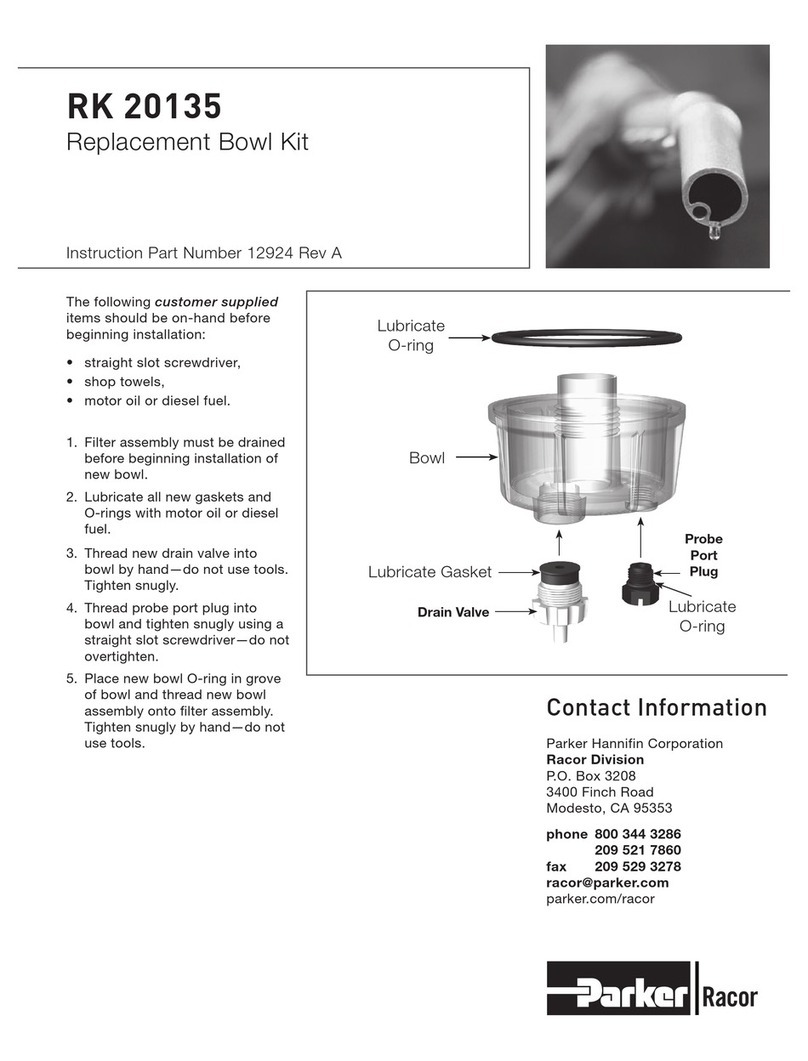
Parker
Parker Racor RK 20135 instructions

amiad
amiad TEQUATIC PLUS F-150 Installation, operation and maintenance manual
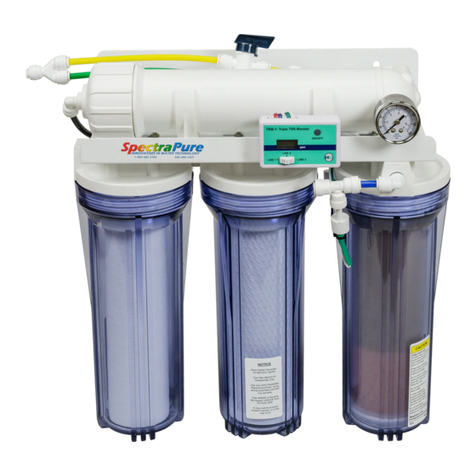
SpectraPure
SpectraPure CSPDI-90-MF Installation and operating manual
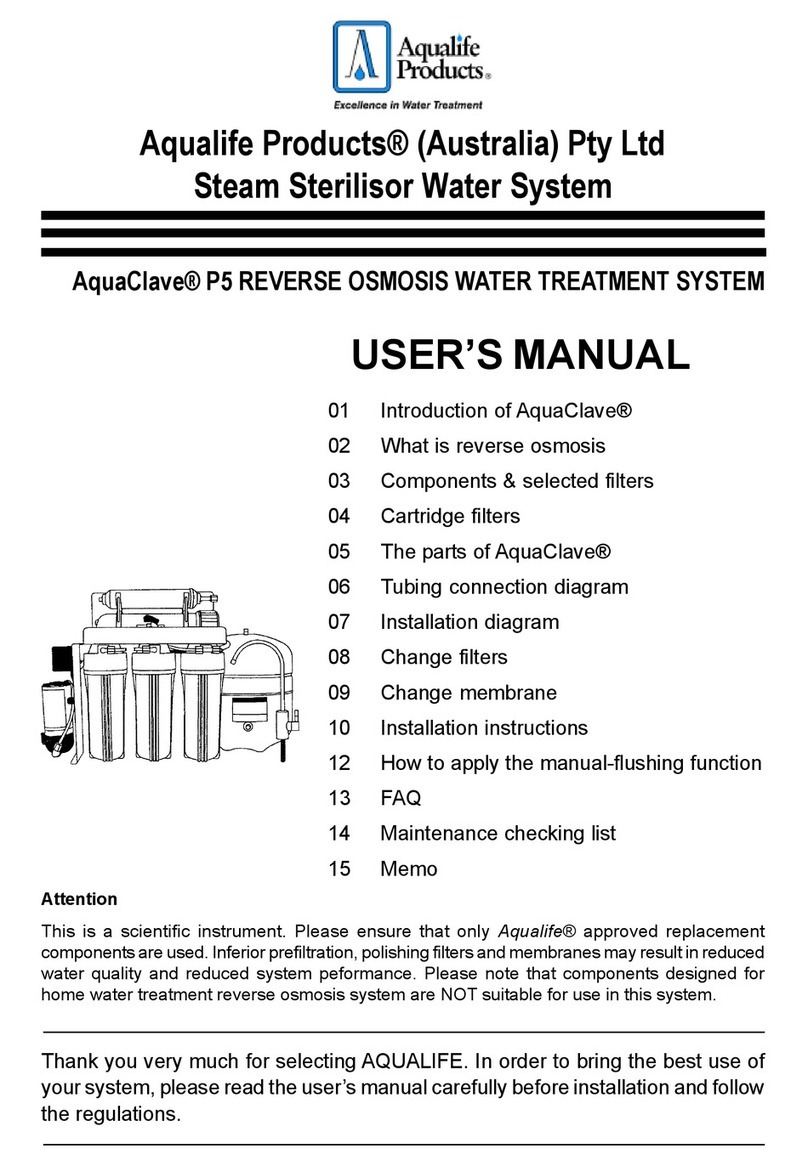
Aqualife
Aqualife AquaClave P5 user manual
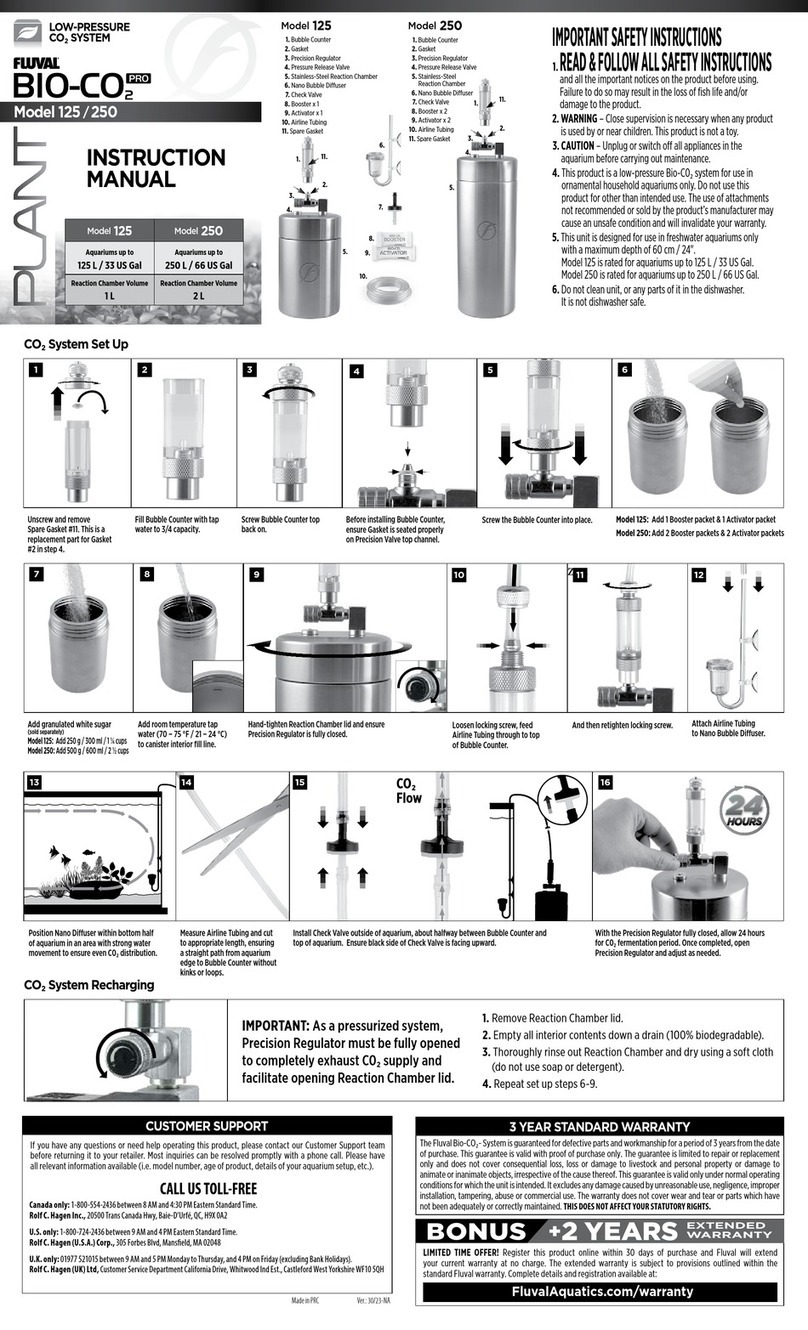
Fluval
Fluval BIO-CO2 PRO 125 instruction manual
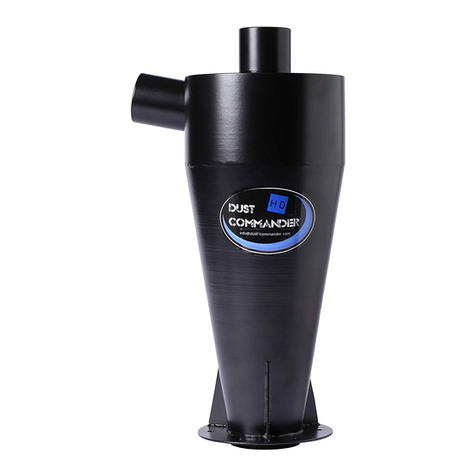
Sulaco A.I.R Works
Sulaco A.I.R Works DUST COMMANDER Installation, operation and maintenance manual
